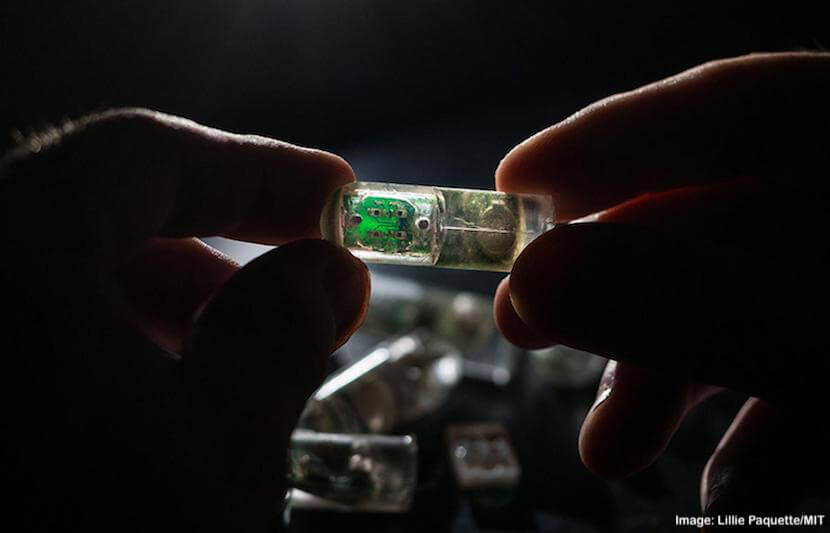MIT researchers have developed an ingestible sensor that can detect stomach bleeding or other gastrointestinal problems, and relay the information to a nearby smartphone.
Working in the field of synthetic biology, the researchers infused an electronic sensor with genetically modified bacteria that can emit light in response to blood and convey the information via wireless transmission.
This device, they believe, could provide an alternative to invasive or unnecessary procedures that are currently used to detect stomach bleeding or other gastrointestinal disorders.
The study appeared in the online edition of the journal Science.
Engineering bacteria-on-a-chip
In the past decade, researchers have successfully engineered bacteria to respond to stimuli such as environmental pollutants or markers of disease.
Through this process of genetic engineering, bacteria can be designed to produce various signals, such as emitting light, when a target stimulus is detected. However, in most cases, specialized lab equipment is required to measure these responses.
Now, MIT researchers have developed a way to make the process more useful for real-world applications, by combining the bacteria with an electronic chip.

The study
In their initial study, the researchers focused on bleeding in the gastrointestinal tract of pigs.
To do this, they genetically engineered a probiotic strain of E. coli that can emit light in response to a component of blood called Heme.
“By modifying a bacterium’s DNA, we can program it to perform new function, such as producing light in response to a target stimulus. In this case, we found genes from different strains of bacteria that could perform the necessary functions: import the analyte into the cell, alter gene expression in response to the analyte, and encode enzymes that can produce light,” said Mark Mimee, a student in MIT’s Microbiology Graduate Ph.D. Program and co-lead author of the study. “By combining these genetic elements and tuning their expression levels, we made a strain that can sense blood in the gastrointestinal tract.”
To build the sensor, the researchers placed the bacteria in four wells and covered it with a semipermeable membrane that allows small molecules from the environment to diffuse through.
Under each well is a phototransistor that can measure the amount of light emitted from the bacterial cells, and then relay the information to a microprocessor that sends a wireless signal to a nearby computer or smartphone.
The researchers also built an Android app that can be used to analyze the data.
“Our idea was to package bacterial cells inside a device,” Phillip Nadeau, former MIT postdoctoral associate and co-lead author of the study, said in a statement. “The cells would be trapped and go along for the ride as the device passes through the stomach.”
The findings
So far, the sensor has been successful in determining whether any blood is present in the stomach of pigs.
“What we have shown is that we can take this technology off the lab bench and perform sensing inside the body itself, with wireless readout to a phone,” said Nadeau. “This bring us one step closer to clinical translation by showing that living cell-based sensors can be packaged as an ingestible capsule and perform sensing inside the stomach.”
The researchers believe this type of sensor could be used either for one-time use or designed to stay in the digestive tract for several days or weeks, sending continuous signals.
In addition, the researchers have adapted sensors for two other molecules, which have not yet been tested on animals.
One of these sensors detects a sulfur-containing ion called thiosulfate, which could be used to monitor inflammatory conditions, including Crohn’s disease.
The other detects a bacterial signaling molecule called AHL, which can serve as a marker for gastrointestinal infections.
The researchers believe the sensors could be designed to treat a variety of conditions.
“Most of the work we’ve done has focused on sensing blood in the pig gastric cavity. However, we think that expanding the range of biosensors to other gastrointestinal diseases, such as inflammatory bowel disease, infection or cancer can propel its future clinical utility,” said Mimee
The next step
The sensor is about 1.5 inches long, and requires around 13 microwatts of power. It’s equipped with a 2.7 volt battery, which is estimated to power the device for around 1.5 months of continuous use.
For human applications, however, the researchers need to decrease its size to minimize complications.
“The safety of the device is really about the size of the capsule and the safety of the packaging materials used to insulate the electronics,” said Nadeau. “Similar to what other manufacturers of ‘Smart Pills’ containing electronics have done, we expect to confirm that our capsule will be safe for ingestion in humans.”
Though the study is still in preliminary stages, the researchers are confident of its future applications.
“At the moment, we’re still in the prototype stage. With a couple more years of development by broadening the range of available biosensors and reducing the size of the capsule, we would be excited to start safety trials in humans,” said Mimee.
Ultimately, the researchers believe that the sensors will be a safe alternative to current procedures. For instance, a patient suspected of stomach bleeding would not have to undergo an endoscopy, a procedure which often requires sedation.
“The goal with this sensor is that you would be able to circumvent an unnecessary procedure by just ingesting the capsule, and within a relatively short period of time you would know whether or not there was a bleeding event,” Mimee said in a statement.



